Authentic Biryani Recipes: Mastering the Art of Indian Biryani
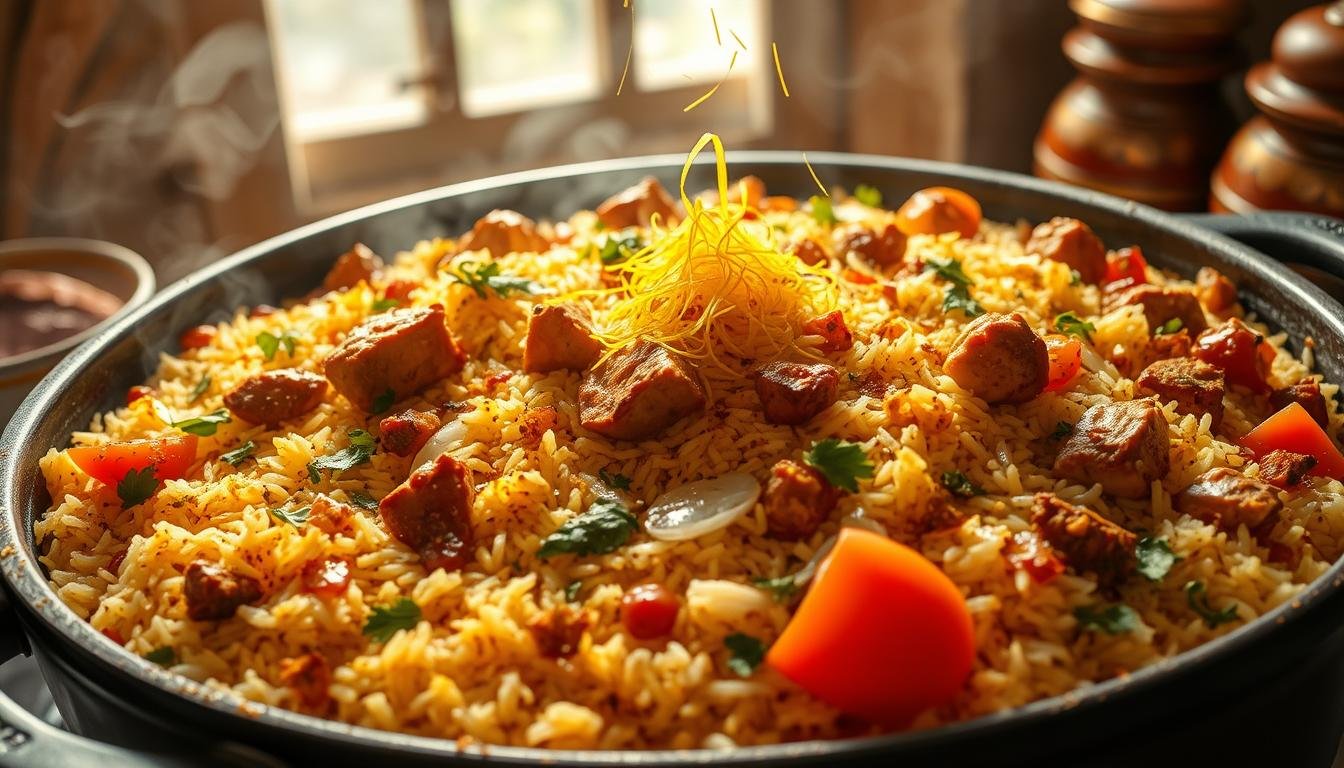
Ever thought about what makes a biryani truly stand out?
Biryani isn’t just any dish; it’s an art. It needs patience, skill, and deep flavor knowledge. Whether you’re a kitchen pro or new, excited by Indian food’s smells, biryani is a journey. It involves detailed layering and a perfect spice mix. This makes biryani both challenging and fun.
Let’s start a tasty trip with authentic biryani recipes. We’ll learn about Indian biryani’s history and kinds. And we’ll find out how to make a dish full of flavor and tradition. See how good ingredients and careful cooking make your biryani as good as any top restaurant. Are you ready to discover the tasty secrets of biryani?
Introduction to Biryani
Biryani is a tasty rice dish loved for many years. It is a big part of authentic Indian cuisine. When you learn about biryani, you’ll find out about its history, different kinds, and special ingredients.

A Brief History of Biryani
The story of biryani history begins long ago in ancient India. Its biryani origins might come from the medieval period. Over time, it changed by adding ideas from Persian and Mughal foods. Each spice and way of cooking tells a story from the past. It brings together tales of culture and tradition.
Regional Variations of Biryani
Different places make biryani in their own ways. These regional biryani styles show the variety in cooking. For example, Hyderabadi biryani is quite spicy and rich. However, the Kolkata type has boiled eggs and potatoes, making it different.
Each place in India has its own biryani style:
- Hyderabadi Biryani: Famous for its aromatic spices and saffron rice.
- Lucknowi (Awadhi) Biryani: It has gentle flavors and smells great because of its biryani ingredients.
- Kolkata Biryani: Known for adding potatoes and boiled eggs.
- Sindhi Biryani: Very spicy and full of flavors.
Ingredients That Define Biryani
Biryani isn’t just rice and meat. The special biryani ingredients make it amazing. Ingredients like basmati rice, saffron, cardamom, and cloves are important. The chicken or mutton is also special. It’s soaked in yogurt and spices, making every bite delicious.
Let’s look at the most common ingredients:
| Ingredient | Role in Biryani |
|---|---|
| Basmati Rice | Gives the long, sweet-smelling grains needed for biryani. |
| Whole Spices | They add layers of taste, including cloves, cardamom, and bay leaves. |
| Marinated Meat | It’s the main part of the dish, usually marinated with yogurt and spices. |
| Saffron | Gives a beautiful color and unique taste. |
| Ghee | Makes the biryani richer and tastier. |
Essential Biryani Cooking Techniques
Making perfect biryani means knowing key cooking steps. These steps add rich and complex flavors. Let’s explore the basic techniques to make your biryani tasty and authentic.
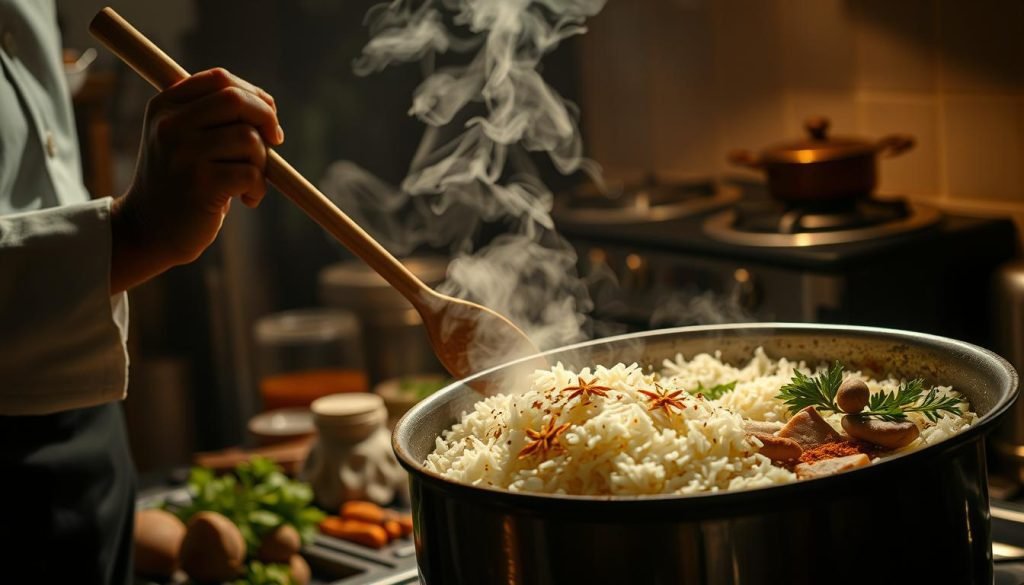
Layering the Flavors
Layering biryani is like painting a picture, where each layer adds a special touch. Start by cooking the rice until it’s ¾ done. It should be slightly firm in the middle. Then, lay down fried onions, called birista, in your pot.
Put marinated meat or veggies on top of the onions. Make sure it’s spread out well. Next comes a layer of rice, spices, and saffron milk made from ¼ teaspoon of saffron in 3 tablespoons of hot milk. Finish with mint and coriander leaves on top.
This way of layering creates a mix of tastes in each bite.
The Perfect Sauté
Frying onions till they’re golden adds a lot of flavors. Use ¼ cup of ghee for this. From one big onion, you can get about 1 to 1.5 cups of fried onions. They’re important for the biryani’s rich taste.
Also, fry any meat or veggies with spices like biryani masala. Add red chili powder and turmeric. Marinate with 2/3 cup of yogurt and ¾ teaspoon salt. This makes the meat tender and tasty.
Mastering the Dum Cooking Method
The dum method cooks food slowly, keeping all the flavors inside. Put the biryani in a heavy pot. Seal the top with a tight lid or dough around the edges.
Cook on a medium-high flame for 15 to 20 minutes, then on low for 15 more minutes. You can also bake the biryani for 30 to 40 minutes at 390°F (200°C). After cooking, let the biryani sit for 20 minutes. This avoids too much moisture and mixes the flavors well.
| Steps | Instructions |
|---|---|
| Rice Preparation | Soak for 30-40 minutes, cook until ¾th done. |
| Frying Onions | Sauté onions in ¼ cup ghee; yield 1-1.5 cups per onion. |
| Marination | Use 2/3 cup yogurt, ¾ tsp salt, and spices. |
| Layering | Alternate rice, meat/vegetables, birista, spices, saffron milk. |
| Dum Cooking | Cook sealed pot on medium-high for 15-20 mins, then on low for 15 mins; or bake at 390°F for 30-40 mins. |
| Resting | Rest the biryani for at least 20 mins. |
Popular Types of Biryani
Biryani is a famous Indian food known for its yummy tastes. Different places in India have their own special biryanis. Let’s look at the most loved biryanis from various parts of India.
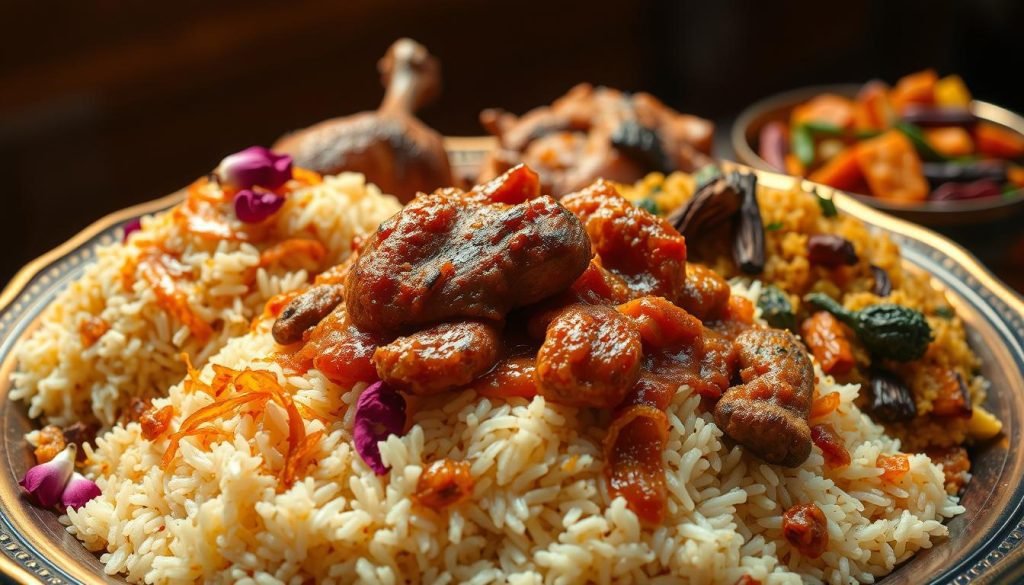
Hyderabadi Biryani
Hyderabadi biryani is a top favorite in India. It comes from South India and is spicy and smells great. It has half-cooked rice, marinated meat, fried onions, and green herbs like mint. The dum way of cooking mixes all the flavors well, making it very tasty.
Lucknowi (Awadhi) Biryani
Lucknowi biryani, or Awadhi biryani, has a special way of cooking. It comes from Persian ways of making food. The meat and rice are cooked apart and then put together. This makes every rice grain tasty and separate. This biryani is less spicy and is nice with Raita on the side.
Kolkata Biryani
Kolkata biryani is different because it has potatoes and eggs. It also has sweet smelling things like rose water. This biryani is sweet and light yellow, making it popular in East India. It is not very spicy but very fragrant.
Sindhi Biryani
Sindhi biryani comes from Sindh and is very spicy and sour. It has a lot of spices, green chilies, and herbs. Yogurt and tomatoes make it zesty and different. It’s a bright red biryani with a strong taste, loved in Pakistani and Sindhi homes.
Here’s a quick look at these famous biryanis:
| Type of Biryani | Key Ingredients | Origin |
|---|---|---|
| Hyderabadi Biryani | Half-boiled rice, marinated meat, fried onions, mint, coriander | Hyderabad (South India) |
| Lucknowi (Awadhi) Biryani | Separately cooked meat and rice, mild spices, saffron | Lucknow (North India) |
| Kolkata Biryani | Potatoes, boiled eggs, rose water, saffron | Kolkata (East India) |
| Sindhi Biryani | Spices, green chilies, tomatoes, yogurt | Sindh (Pakistan) |
Vegetarian Biryani Recipes
Looking for yummy biryanis without meat? Vegetarian biryani recipes are full of flavor with great ingredients. If you love veggies or paneer in your biryani, these recipes won’t disappoint.
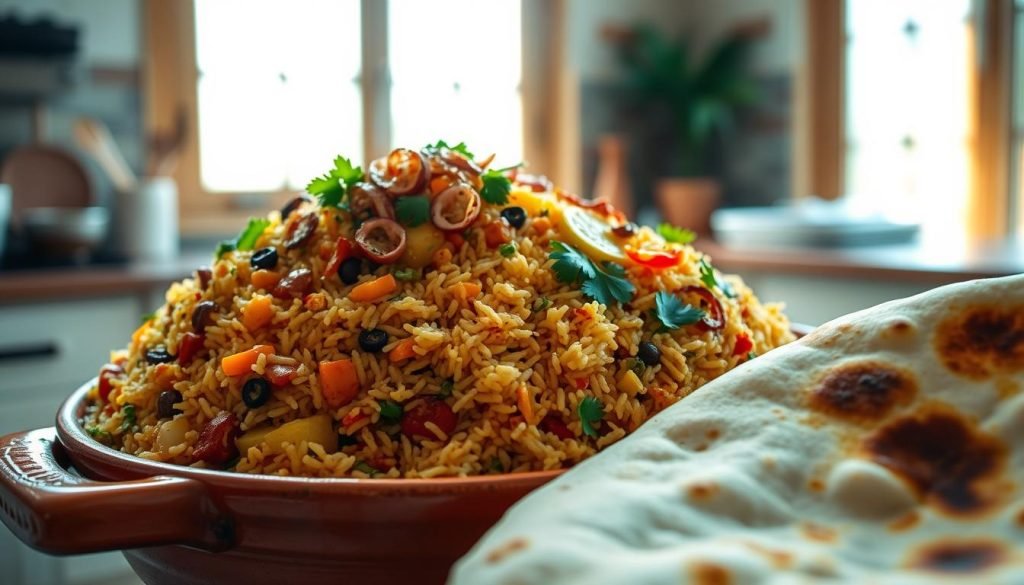
Vegetable Biryani
Vegetable biryani is a favorite for vegetarians. It mixes basmati rice, bright veggies, and spices. It’s both tasty and good for you.
- Soak 200 grams (1 cup) of basmati rice in 24 ounces (3 cups) of water for 30 minutes.
- Cook rice until 70-75% cooked (approximately 6-7 minutes).
- Caramelize 2 medium-sized red onions, thinly sliced.
- Include 1.5 tablespoons of ghee and 2 tablespoons of broken cashews for added richness.
- Add a mix of vegetables: 1 small cubed potato, ½ cup of cauliflower florets, 1 medium carrot, and 5-6 green beans.
- Use 2 tablespoons of milk with saffron strands for preparing saffron milk.
- Season with 1.5 teaspoons of biryani masala or 1 teaspoon of garam masala and ½ teaspoon of kashmiri red chili powder.
Layer everything in a pot and cook on low for 25 to 30 minutes with the dum method. Add cilantro, mint, and rose water for flavor.
Paneer Biryani
Paneer biryani brings paneer cheese into the mix. It’s aromatic and filling, great for any meal. It starts like vegetable biryani but has special steps.
- Incorporate 250 grams (around 8.8 ounces) of paneer, cubed, into the recipe.
- Marinate paneer with a mixture of 1/3 cup (around 80 ml) of yogurt, 1.5 teaspoons of biryani masala, and a pinch of salt for 30 minutes.
- Fry the marinated paneer until golden brown before layering it into the biryani.
- Use the same process for cooking the rice, but adding the paneer in alternate layers with the vegetable mixture.
Paneer adds to the layers, making a rich, tasty biryani. The dum cooking method locks in the flavors.
These recipes are a hit online, with around 50,000 shares. They show how mixtures of flavors and fresh ingredients can deliver delicious meals.
| Ingredient | Vegetable Biryani | Paneer Biryani |
|---|---|---|
| Basmati Rice | 200 grams | 200 grams |
| Ghee | 1.5 tablespoons | 1.5 tablespoons |
| Onions | 2 medium, thinly sliced | 2 medium, thinly sliced |
| Vegetables | Mixed (potato, cauliflower, carrot, green beans) | Mixed (potato, cauliflower, carrot, green beans) |
| Paneer | N/A | 250 grams, cubed |
| Yogurt | 1/3 cup | 1/3 cup for marinating paneer |
| Spices | Biryani masala, garam masala, kashmiri red chili powder | Biryani masala, garam masala, kashmiri red chili powder |
| Cooking Method | Dum cooking | Dum cooking |
Chicken Biryani Recipes
Diving into chicken biryani means exploring wonderful smells, flavors, and traditions. You can try making a classic chicken biryani. Or, you might like an easier, one-pot version. Each way of making it brings a special taste and charm.
Traditional Chicken Biryani
Making an authentic, traditional chicken biryani requires balance. Layers of spices and tender chicken need to be just right. The “dum” cooking method is used here. This means cooking rice and chicken together slowly. This lets their flavors mix well together. It’s important to have the right chicken and rice amount. For example, 1.5 lb of chicken goes with 2.25 cups of rice. This is enough for 6-8 people. The chicken should be marinated. This can be from 2 hours to all night. Use yogurt, ginger-garlic paste, and spices like turmeric, cardamom, and cinnamon.
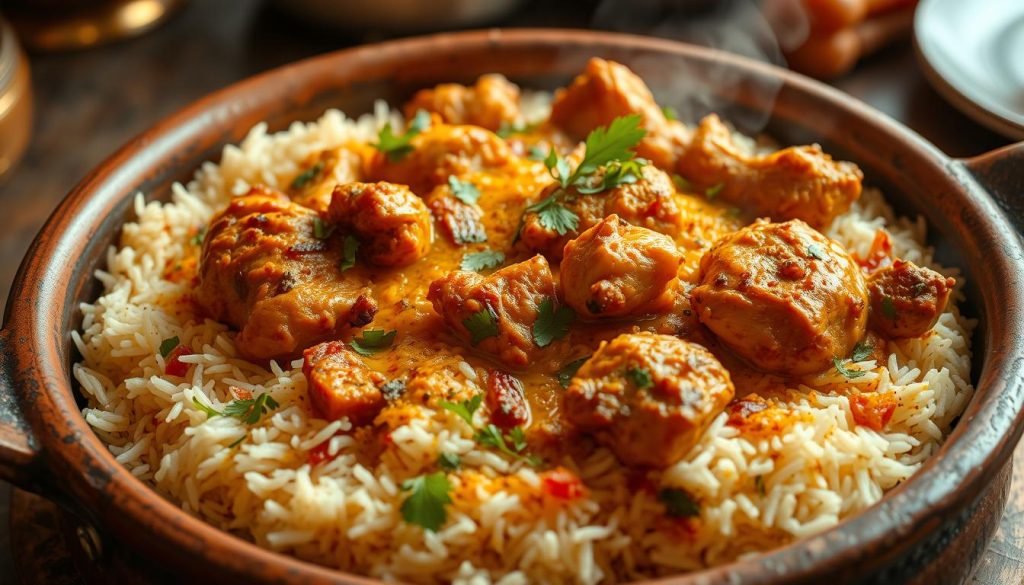
Searing the chicken is key. It adds lots of flavor. It should cook 5 minutes on one side and 4 minutes on the other. Then, take it out of the pot. Onions and ginger need about 8 minutes to get soft. Next, layer the rice, chicken, and spices. The last step is to cook everything for about 18 minutes. This makes the rice soft and cooks the chicken all the way.
One-Pot Chicken Biryani
The one-pot chicken biryani is perfect for those who want it easy. It’s great for busy nights or if you’re new to cooking. Everything cooks together in one pot. This makes things simple and keeps the great taste of the dish.
Start with chicken thighs that have bones and skin (about 1.5 pounds for 1.5 cups of basmati rice). You’ll need 2.5 cups of chicken stock or water for the rice. This recipe takes about 1 hour from beginning to end. This includes 18 minutes of simmering. This is when the rice and chicken cook together. Adding golden raisins adds a bit of sweetness. A topping of almonds, either whole or sliced, adds crunch. This recipe shows you can have a dish focused on rice that still has plenty of protein.
Whether you pick the layered traditional chicken biryani or the simple one-pot version, each offers an enjoyable cooking experience. Serve with raita and naan. This makes a full, delicious meal. It’s a great way to celebrate one of India’s favorite dishes.
Lamb and Goat Biryani Recipes
Lamb and goat biryani mix spices and meat into a yummy dish. Learn how to make perfect biryani with these recipes. You’ll find recipes for Mutton Biryani with Yogurt and Spicy Goat Biryani here.
Mutton Biryani with Yogurt
Mutton biryani is more complex than mutton pulao. You can use the kacchi (raw) or pakki (cooked) method. For the kacchi method, marinate mutton in full-fat yogurt, like Greek yogurt, overnight.
Use spices like bay leaves, cloves, and cinnamon sticks. Add fried onions when marinating and layering for extra flavor. The right dum cooking method makes the meat tender and very fragrant.
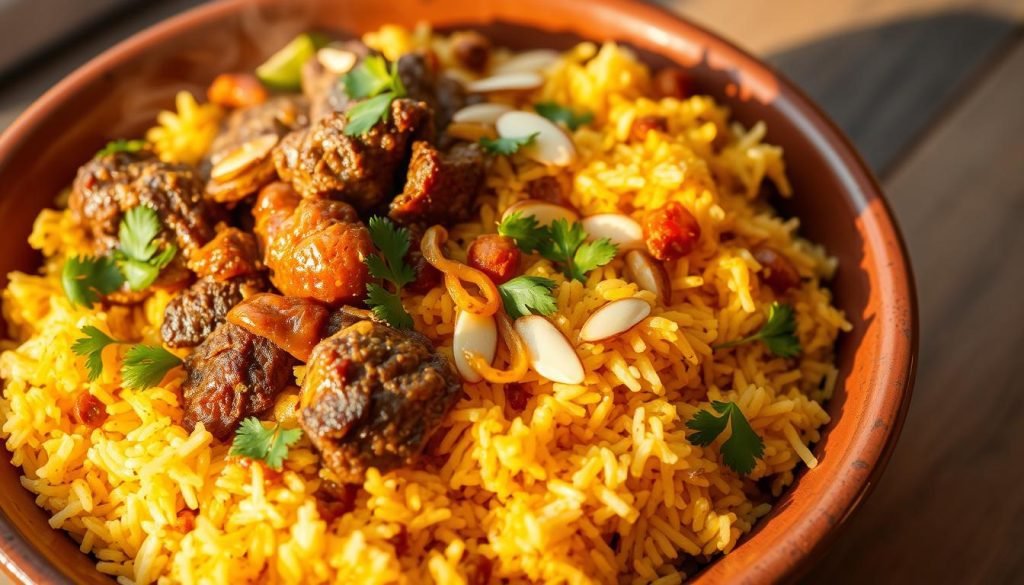
| Ingredient | Amount |
|---|---|
| Basmati Rice (soaked for 30-40 mins) | 2 ½ cups |
| Lamb or Mutton | ½ kg |
| Plain Yogurt | 2 tablespoons |
| Fried Onion | 4 units |
| Cooking Oil | ¼ cup |
| Salt | to taste |
| Water | 7 ½ cups |
| Saffron (soaked in warm milk) | ½ teaspoon |
Add ginger garlic paste to marinate, reducing gamey taste. Cook slowly for 1 to 1.5 hours for tender meat.
Spicy Goat Biryani
Spicy goat biryani is known for its strong flavors. Marinate goat meat overnight for deep flavor.
This biryani uses whole spices and aged basmati rice. Cook it under pressure, then dum cook for perfect tenderness.
Mix in fried onions, cilantro, mint leaves, tomatoes, and red pepper. The right balance of rice to meat and cooking technique are key.
Seafood Biryani Recipes
If you love seafood, you’ll enjoy our seafood biryani recipes. They mix rich spices with seafood flavors. Let’s look at prawn biryani and fish biryani recipes.
Prawn Biryani
Prawn biryani has tender prawns, fragrant rice, and spices. We’ll show you how to make it.
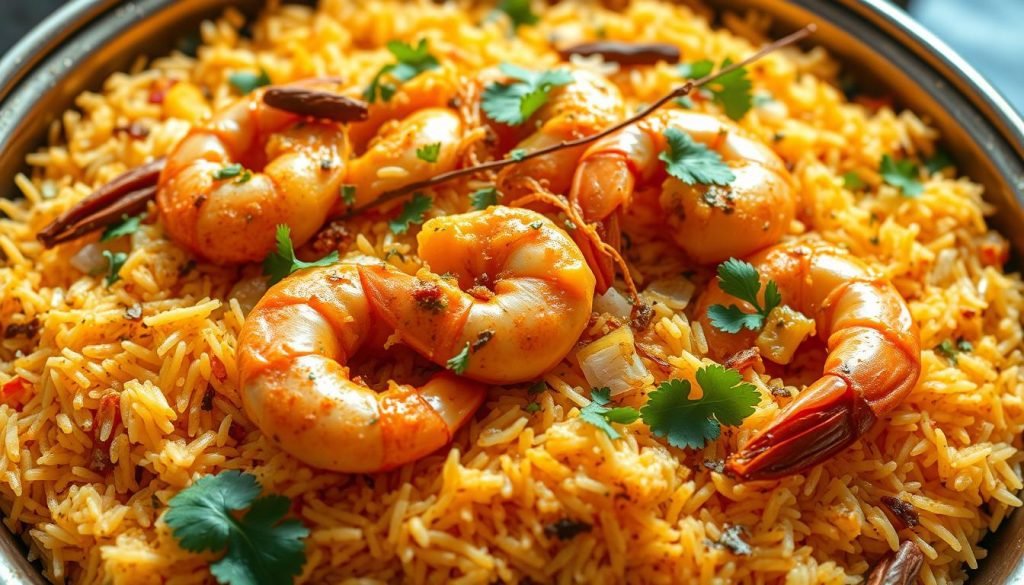
- Prep Time: 30 minutes
- Cook Time: 30 minutes
- Total Time: 1 hour
- Servings: 5
- Calories per serving: 585 kcal
Marinate 250 grams of prawns. Use ginger garlic paste, turmeric, biryani masala, and chili. Marinate for 15 minutes. Cook prawns for 3 minutes until they’re “C” shaped. They’ll be juicy and tasty.
Prawn biryani is nutritious.
| Nutrient | Amount | % Daily Value |
|---|---|---|
| Calories | 585 kcal | – |
| Total Fat | 15 g | 23% |
| Saturated Fat | 4 g | 25% |
| Cholesterol | 210 mg | 70% |
| Sodium | 1063 mg | 46% |
| Potassium | 380 mg | 11% |
| Carbohydrates | 83 g | 28% |
| Fiber | 3 g | 13% |
| Sugar | 2 g | 2% |
| Protein | 25 g | 50% |
| Vitamin A | 490 IU | 10% |
| Vitamin C | 16.9 mg | 20% |
| Calcium | 182 mg | 18% |
| Iron | 4.4 mg | 24% |
Fish Biryani
Fish biryani gives a new taste to biryani. It has great spices and fish.

- Preparation Time: About 45 minutes
- Recommended Rice: 1.5 cups basmati rice (soaked for 20-30 minutes)
- Total Cooking Water: 4.5 to 5 cups
Cook rice until it’s just right. Fry fish pieces properly. They should be crispy outside but tender inside.
- Total Preparation Time for Dum: 12 minutes
- Recommended Resting Time After Cooking: About 15 minutes
Fish biryani also offers good nutrition.
| Nutrient | Amount | % Daily Value |
|---|---|---|
| Calories | 599 kcal | – |
| Total Fat | 8 g | 12% |
Prawn and fish biryani will make your meals exciting. They promise great taste.
Tips for the Perfect Biryani
Making the perfect biryani is like creating art. You need the right ingredients, skills, and timing. Follow these tips for a yummy dish that everyone will love. We’ll look at choosing rice, picking spices, and the right cook time and temp.
Choosing the Right Rice
Picking the right rice is crucial for great biryani. Use aged basmati rice for its smell and long grains. You must partly cook the rice before mixing it in. For rice that’s partially cooked, boil for 5 minutes and then drain well.
Spice Blends for Authentic Flavor
For real biryani flavor, mixing spices right is key. Different biryanis have different tastes. For example, Hyderabadi biryani is spicy and Lucknowi has a sweetish taste. Mix your spices well to create a paste. This stops the rice from getting wet.
Cooking Time and Temperature
Getting the cook time and temp right is important. Use a thick pot for even heating. Marinate your chicken for a long time to make it tasty. Cook this marinated chicken for about 7 minutes. Fry onions until they are golden for topping. The dum method helps mix all flavors well in the biryani.
Biryani Accompaniments
Enjoying biryani is better with the right side dishes. There are various sides like raita, salads, and pickles. These additions balance the biryani’s rich taste and make the meal complete.
Raita Recipes
Raita is a favorite side for biryani. It cools down the spice and enriches the dish. You can try cucumber or boondi raita among other types.
- Cucumber Raita: Made with grated cucumber and yogurt, this soothing raita is a favorite.
- Boondi Raita: This gluten-free variant, made with crunchy boondi (fried chickpea flour droplets), is commonly served with spicy biryani.
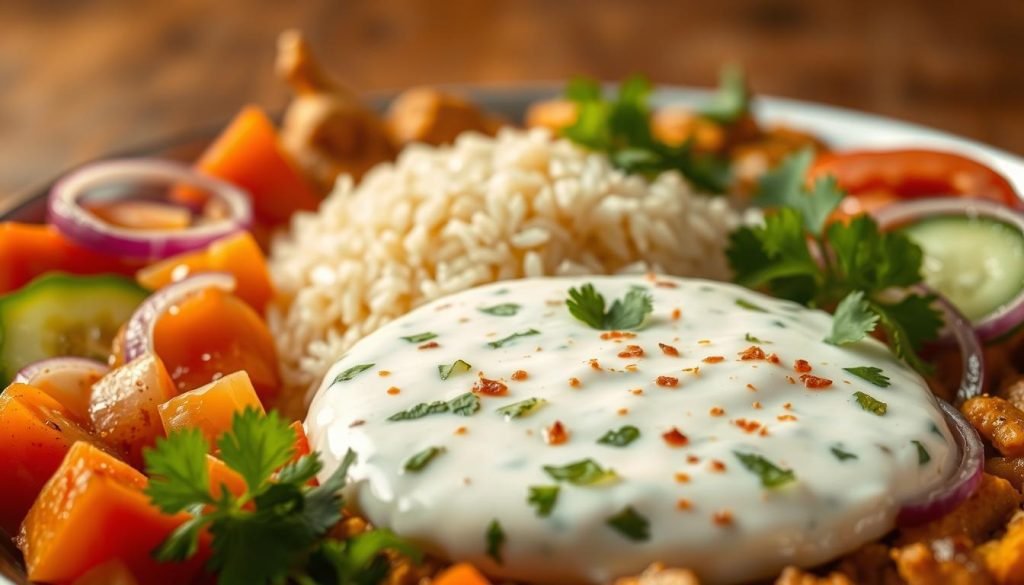
Salads and Pickles
Salads and pickles add a fresh and tangy taste to biryani. There are options like Kachumber Salad and Fruit Chaat. These are great with biryani.
- Kachumber Salad: A vegan, oil-free, and gluten-free salad made with chopped onions, tomatoes, cucumbers, green chilies, and herbs.
- Fruit Chaat: A tangy-spicy fruit salad that acts as a refreshing side dish for biryani.
- Indian Onion Salad: Characterized as gluten-free and no-oil, suitable for vegetarians and vegans.
Biryani pickles, like mango, add a spicy tang. Mint Cilantro Chutney and Mango Lassi are great too. They really enhance the biryani’s taste.
For a fuller meal, add Chicken Tikka Kebab or Samosas. Mirchi Ka Salan and Chana Paneer also go well. They make the meal richer and more satisfying.
Troubleshooting Common Biryani Issues
Even the best chefs can run into problems when making biryani. Knowing how to fix these issues will help make your dish perfect. We’ll talk about how to make biryani rice better and how to get the flavors just right.
Overcooked Rice Solutions
Overcooked rice can ruin biryani, making it too soft. Using Basmati rice helps because it’s less starchy than other kinds. This means it won’t get mushy as easily.
Soak the rice for 20-30 minutes before you cook it. This makes the grains expand the right way and cook evenly. Also, cook the rice until it’s 40% done before adding it to the Biryani Jhol. This step helps with both flavor and texture.
Don’t forget to season the water well when cooking the rice. It should taste saltier than you think. This makes the rice tastier and adds to the biryani’s overall flavor.
Balancing Flavors
Getting the biryani flavors just right can be hard because of all the spices. A good rule is to have twice as much rice as onions. Use homemade Biryani masala for a better smell and taste. Adding special spices like Mace and Saffron makes your dish smell like it came from a restaurant.
Some secret ingredients like jardaloo make Hyderabadi biryani special. Even though not all recipes use them, they can make your biryani taste more authentic.
It’s important to remember that some ingredients are just for their taste and not to eat. Try different things to see what works best. This will help you make the perfect biryani.
Conclusion
Biryani mastery takes you deep into authentic Indian cooking. We’ve talked about its history, how to cook it, and its flavors. It’s more than food; it’s about tradition, culture, and skill.
Embracing Biryani in Your Cooking
Learning about biryani means loving its many parts. For example, some biryanis are rich and layered, while others are light but tasty. When you cook biryani, you join a long and loved tradition.
It doesn’t matter if you use chicken, mutton, seafood, or veggies. Mixing spices well and preparing carefully matters most.
Final Thoughts on Authenticity and Taste
Authentic biryani is not just about recipes. It’s also knowing its culture and history. Using the best rice and saffron, plus spices, captures biryani’s royal spirit.
As you get better at making biryani, remember its real joy. Sharing it with those you care about is what makes it truly unique. Love the learning, enjoy the tastes, and honor the heritage of Indian cooking.